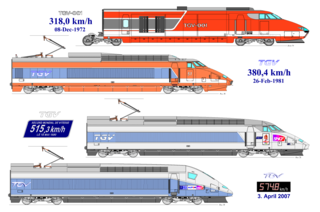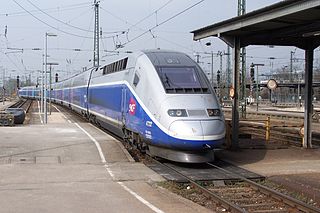
The TGV is France's intercity high-speed rail service, operated mainly by SNCF. SNCF worked on a high-speed rail network from 1966 to 1974 and presented the project to President Georges Pompidou who approved it. Originally designed as turbotrains to be powered by gas turbines, TGV prototypes evolved into electric trains with the 1973 oil crisis. In 1976 the SNCF ordered 87 high-speed trains from Alstom. Following the inaugural service between Paris and Lyon in 1981 on the LGV Sud-Est, the network, centered on Paris, has expanded to connect major cities across France and in neighbouring countries on a combination of high-speed and conventional lines. The TGV network in France carries about 110 million passengers a year.

A gas turbine locomotive is a type of railway locomotive in which the prime mover is a gas turbine. Several types of gas turbine locomotive have been developed, differing mainly in the means by which mechanical power is conveyed to the driving wheels (drivers). A gas turbine train typically consists of two power cars, and one or more intermediate passenger cars.

The TGV Atlantique (TGV-A) is a class of high-speed trains used in France by SNCF; they were built by Alstom between 1988 and 1992, and were the second generation of TGV trains, following on from the TGV Sud-Est trainsets. The trains were named after the Ligne à Grande Vitesse Atlantique that they were originally built for.

The SNCF TGV Réseau (TGV-R) is a TGV train built by Alstom between 1992 and 1996 for SNCF, the French national railway for use on high-speed TGV services. The Réseau trainsets are based on the earlier TGV Atlantique. The first Réseau sets entered service in 1993.

The TGV La Poste were dedicated trainsets for high-speed freight and mail transportation by French railway company SNCF on behalf of the French postal carrier La Poste. The top speed of this TGV Sud-Est derivate was 270 km/h (168 mph), making them the fastest freight trains in the world. They were withdrawn in 2015.

The JetTrain was an experimental high-speed passenger train concept created by Bombardier Transportation in an attempt to make European-style high-speed service more financially appealing to passenger railways throughout North America. It was designed to use the same LRC-derived tilting carriages as the Acela Express trains that Bombardier built for Amtrak in the 1990s, which used all-electric locomotives. Unlike the Acela, powered electrically by overhead lines, the JetTrain would have used a combination of a 4,000-horsepower (3.0 MW) gas-turbine engine, a low-power diesel engine, a reduction gearbox, and two alternators to power electric traction motors. This would have allowed it to run at high speeds on non-electrified lines.

SNCF Class T 2000 trainsets, also known under their French acronym RTG, were the second generation of turbine-powered trains in France and saw commercial service from 1972 to 2004.

The SNCF TGV Sud-Est was a French high speed TGV train built by Alstom and Francorail-MTE and operated by SNCF, the French national railway company. A total of 111 trainsets were built between 1978 and 1988 for the first TGV service in France between Paris and Lyon which opened in 1981. The trainsets were semi-permanently coupled, consisting of two power cars (locomotives) and eight articulated passenger carriages, ten in the case of the tri-voltage sets. The trains were named after the Ligne à Grande Vitesse Sud-Est that they first operated on. They were also referred to as TGV-PSE, an abbreviation of Paris Sud-Est.

Thalys PBKA is a high-speed trainset, manufactured by the French company GEC-Alsthom, and used on the international Eurostar service. Originally built for Thalys they were intended to operate between Paris, Brussels, Köln and Amsterdam, forming the abbreviation PBKA. They were initially intended to be sole rolling stock of the service, but their extreme cost and complexity due to their quadri-current capability led the order of a simpler tri-current sister class, the Thalys PBA, a TGV Réseau derivative, with which they can work in multiple.

The TGV POS is a TGV train built by French manufacturer Alstom which is operated by the French national rail company, the SNCF, in France's high-speed rail lines. It was originally ordered by the SNCF for use on the LGV Est, which was put into service in 2007. POS is an abbreviation of Paris-Ostfrankreich-Süddeutschland, the route of the LGV Est.

The TGV Duplex is a French high-speed train of the TGV family, manufactured by Alstom, and operated by the French national railway company SNCF. They were the first TGV trainsets to use bi-level passenger carriages with a seating capacity of 508 passengers, increasing capacity on busy high-speed lines. While the TGV Duplex started as a small component of the TGV fleet, it has become one of the system's workhorses.

The TGV 001 was an experimental gas turbine-powered TGV prototype built by Alstom in France. Comissioned in 1969, began testing in 1972 and reached speeds between 250–300 kilometres per hour (160–190 mph). It was part of a vast research program on high rail speeds which covered all technical aspects, principally traction, the behaviour of the vehicles, braking, aerodynamics and signalling. Originally, two trains were to be built, but only one was produced. The second was to be a tilting train equipped with an active tilting system, but was abandoned owing to technical difficulties.
The TGV is France's high-speed rail service. The idea of a high-speed train in France was born about twenty years before the first TGVs entered service. At that time, about 1960, a radical new concept was thought up; combining very high speeds and steep grades would allow a railway to follow the contours of existing terrain, like a gentle roller coaster. Instead of one or two percent grades which would be considered steep in normal applications, grades up to four percent would be feasible, thus allowing more flexible routing of new lines. Over the next several years, this very general idea gave rise to a variety of high speed transportation concepts, which tended to move away from conventional "wheel on rail" vehicles. Indeed, the French government at the time favoured more "modern" air-cushioned or maglev trains, such as Bertin's Aérotrain; Steel wheel on rail was considered a dead-end technology. Simultaneously, SNCF was trying to raise the speeds of conventional trains into the range 180 to 200 km/h for non-electrified sections, by using gas turbines for propulsion. Energy was reasonably cheap in those years, and gas turbines were a compact and efficient way to fulfil requirements for more power. Following on the TGS prototype in 1967, SNCF introduced gas turbine propulsion with the ETG turbotrains in Paris - Cherbourg service, in March 1970.

The TGV holds a series of land speed records for rail vehicles achieved by SNCF, the French national railway, and its industrial partners. The high-speed trials are intended to expand the limits of high-speed rail technology, increasing speed and comfort without compromising safety.

The UAC TurboTrain was an early high-speed, gas turbine train manufactured by United Aircraft that operated in Canada between 1968 and 1982 and in the United States between 1968 and 1976. It was one of the first gas turbine-powered trains to enter service for passenger traffic, and was also one of the first tilting trains to enter service in North America.

The Turboliners were a family of gas turbine trainsets built for Amtrak in the 1970s. They were among the first new equipment purchased by Amtrak to update its fleet with faster, more modern trains. The first batch, known as RTG, were built by the French firm ANF and entered service on multiple routes in the Midwestern United States in 1973. The new trains led to ridership increases wherever used, but the fixed consist that made up a Turboliner train proved a detriment as demand outstripped supply. The high cost of operating the trains led to their withdrawal from the Midwest in 1981.

The Turbomeca Turmo is a family of French turboshaft engines manufacturered for helicopter use. Developed from the earlier Turbomeca Artouste, later versions delivered up to 1,300 kW (1,700 shp). A turboprop version was developed for use with the Bréguet 941 transport aircraft.

France has a large network of high-speed rail lines. As of June 2021, the French high-speed rail network comprises 2,800 km (1,740 mi) of tracks, making it one of the largest in Europe and the world. As of early 2023, new lines are being constructed or planned. The first French high-speed railway, the LGV Sud-Est, linking the suburbs of Paris and Lyon, opened in 1981 and was at that time the only high-speed rail line in Europe.

Avelia Euroduplex, more commonly known as just Euroduplex or TGV 2N2 in France, is a high-speed double-decker train manufactured by Alstom. It is primarily operated by the French national railway company SNCF, and also in operation with the Moroccan national railway company ONCF. It is the 3rd generation of the TGV Duplex.

The first-generation Acela Express trainset is a unique set of vehicles used on the Acela, Amtrak's flagship high-speed service along the Northeast Corridor (NEC) in the Northeastern United States. When they debuted in 2000, the sets were the fastest in the Americas, reaching 150 mph (240 km/h) on 33.9 mi (54.6 km) of the route. They were built between 1998 and 2001 by a consortium of Alstom and Bombardier. Each set has two power cars derived from units that Alstom built for the TGV, and six passenger cars derived from the LRC that Bombardier built for Via Rail.




















